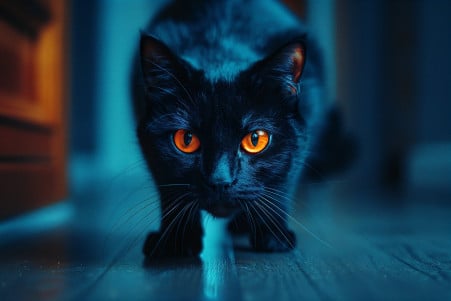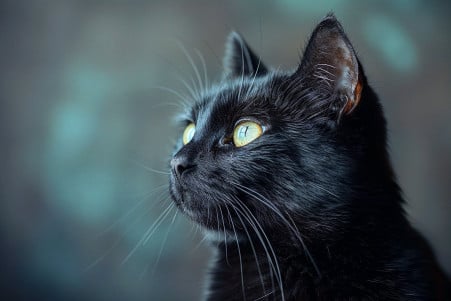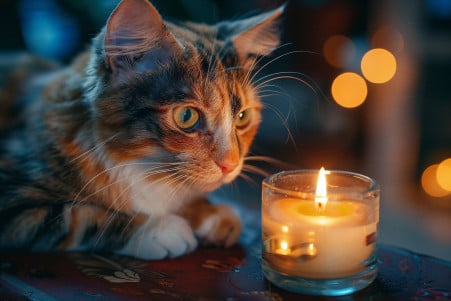Why Do Cats' Eyes Glow in the Dark? The Science Explained
5 June 2024 • Updated 4 June 2024

The glowing eyes of a cat in the dark are a classic horror movie trope, but why do cats' eyes glow? It turns out that cats have a layer of tissue called the tapetum lucidum located behind the retina that enables them to absorb and reflect light more effectively than humans, which helps them see in the dark.
In this article, we'll explore the anatomical and evolutionary reasons for this fascinating cat's eye phenomenon, drawing on studies by veterinary ophthalmologists, comparative biologists, and vision scientists. Together, their work reveals the amazing adaptations that have evolved to help cats and other nocturnal hunters see in dim light. This article will help you appreciate the special eye structures that produce this "eye shine" and the incredible ways that nature has enabled animals to survive and thrive in their natural habitats.
Why do cats' eyes glow in the dark?
Comparative Anatomy: Cats' Eyes vs. Human Eyes
Although cats are famous for their ability to see in the dark, their eyes are actually quite different from human eyes in several important ways. The most obvious of these is the presence of the tapetum lucidum, a reflective layer located behind the retina that increases the amount of light the retina can absorb. This adaptation, which is also present in other nocturnal animals but not in humans, helps cats maximize the light available to them.
In addition to the tapetum lucidum, cats' larger corneas, pupils, and the higher proportion of rods to cones in their retinas all help cats see better in the dark. As explained by Rover.com, the tapetum lucidum reflects light that the retina hasn’t absorbed yet back through the retina, which gives the photoreceptor cells a second chance to detect it. This, combined with the larger pupils that let in more light, makes it possible for cats to see and hunt in the dark.
However, there is a trade-off for this ability. The light that the tapetum lucidum reflects back through the retina can also cause some distortion, which means that cats have less visual acuity than humans during the day. So while cats’ eyes are well-adapted for seeing in the dark, their vision during the day may not be as clear as ours.
It’s also worth noting that some nocturnal primates, such as tarsiers and owl monkeys, have evolved different ways of reflecting light in their eyes. As explained by ScienceDirect, these primates don’t have a tapetum lucidum, but they do have a collagenous tapetum fibrosum, which has a similar effect. This helps these primates see and hunt at night, just as the tapetum lucidum helps cats see and hunt in the dark.
The Science of Eyeshine: Why Do Cats' Eyes Glow?
The color of a cat's eyeshine can range from green to yellow to red to blue. Vetstreet explains that the color of the reflection is determined by a number of factors, including the cat's age, coat color, and eye color, as well as the presence of certain minerals in the tapetum lucidum. The amount of zinc and riboflavin (vitamin B2) in the tapetum lucidum determines the color of the light that is reflected.
In addition, Vetstreet says that cats with blue eyes may not have a tapetum lucidum at all, which means their eyes won't glow. And the Curious Nature blog points out that the color of the eyeshine can change as a cat ages or in certain breeds, such as the odd-eyed cat. These differences in the color of eyeshine are just one example of the many ways cats have adapted to their environments.
Nocturnal Neighbors: Other Animals That Have Eyeshine
While the tapetum lucidum is most commonly associated with cats, it is also found in many other animals, especially those that are nocturnal and either predators or prey. According to Sciencing, dogs, deer, alligators, and cattle are just a few examples of animals that have a tapetum lucidum and exhibit eyeshine. The color of the eyeshine can be different for each species and is determined by the composition and structure of the tapetum lucidum.
In some cases, animals like reindeer can even change the color of their tapetum lucidum seasonally to better match the light conditions in their environment. As noted by NPR, these light-reflecting properties are an example of how these animals have evolved to be able to better survive in their environments and ecological roles, whether they are predators that hunt in the dark or prey that need to be able to better see in low light to avoid danger.
Evolution's Nighttime Advantage: The Tapetum Lucidum's Role
The tapetum lucidum is an evolutionary adaptation that provides a significant advantage for nocturnal and crepuscular animals. According to the Cat Care Clinic, the tapetum lucidum is a key evolutionary adaptation that gives cats enhanced night vision and the ability to detect prey in low light conditions. Its development in kittens and presence in fetal stages suggests its importance from an early age.
The high ratio of rods to cones in the cat's retina, combined with the reflective tapetum lucidum, allows cats to see much better in the dark compared to humans. As noted by the research, cats possess superior night vision, able to detect prey in 1/6th the light needed by humans. This adaptation aids not only nocturnal predators like cats, but also prey animals in detecting potential threats in their environment.
The PubMed study on the development of tapetal rods in cats further demonstrates the evolutionary significance of this adaptation, which has contributed to the survival and success of these species in their respective ecological niches. Understanding the remarkable abilities granted by the tapetum lucidum provides insight into the incredible ways nature equips animals to thrive, even in the darkest of conditions.
Conclusion: The Evolution of Nature's Night Vision
The tapetum lucidum is a fascinating adaptation that has evolved in a wide range of species to help them see in the dark. By reflecting light that wasn't absorbed by the retina back through the eye, the tapetum lucidum enables these animals to maximize the available light and improve their night vision.
As we've seen, the tapetum lucidum isn't unique to cats and is found in many other animals, from predators like raccoons to prey species like deer. The color and brightness of the eyeshine can be influenced by a number of factors, including the composition and maturity of the tapetum, as well as the animal's age and breed.
These adaptations are a testament to the incredible ways nature equips animals to thrive in their respective environments. By understanding the science behind the glowing eyes that peer out from the darkness, we can develop a deeper appreciation for the remarkable feats of evolution that allow these nocturnal marvels to flourish, even in the most challenging conditions.
As we continue to explore and protect the natural world, it is crucial that we preserve these awe-inspiring adaptations for generations to come. The tapetum lucidum and other evolutionary wonders remind us of the beauty and resilience of life, and the importance of coexisting with the diverse species that call our planet home.


